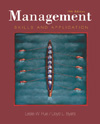 |  Management: Skills and Application, 10/e Leslie W Rue,
Georgia State University - Emeritus
Lloyd L Byars,
Georgia Institute of Technology
Decision-Making Skills
Chapter Summary| 1. Explain the difference between decision making and problem solving. In its narrowest sense, decision making is the process of choosing from among various alternatives. Problem solving is the process of determining the appropriate responses or actions necessary to alleviate a deviation from some standard or desired level of performance. From a practical perspective, almost all managerial decisions involve solving or avoiding problems, and therefore, it is not necessary to distinguish between managerial decision making and managerial problem solving.
2. Distinguish between programmed and nonprogrammed decisions. Programmed decisions are reached by following an established or systematic procedure. Nonprogrammed decisions have little or no precedent and generally require a more creative approach by the decision maker.
3. Explain the intuitive approach to decision making. In the intuitive approach, managers make decisions based on hunches and intuition. Emotions and feelings play a major role in this approach.
4. Discuss two rational approaches to decision making. One rational approach, optimizing, involves the following six steps: (1) recognize the need for a decision; (2) establish, rank, and weigh the criteria; (3) gather available information and data; (4) identify possible alternatives; (5) evaluate each alternative with respect to all criteria; and (6) select the best alternative. A second rational approach, satisficing, is based on the principle of bounded rationality. In the satisficing approach, the decision maker selects the first alternative that meets his or her minimum standard of satisfaction.
5. List the different conditions under which managers make decisions. Managers normally make decisions under the conditions of certainty, risk, or uncertainty.
6. Explain the role values play in making decisions. A manager's values affect the selection of performance measures, alternatives, and choice criteria in the decision process.
7. Summarize the positive and negative aspects of group decision making. Positive aspects include the following: (1) The sum total of the group's knowledge is greater; (2) the group possesses a much wider range of alternatives in the decision process; (3) participation in the decision-making process increases the acceptance of the decision by group members; and (4) group members better understand the decision and the alternatives considered. Negative aspects include the following: (1) One individual may dominate or control the group; (2) social pressures to conform can inhibit group members; (3) competition can develop to such an extent that winning becomes more important than the issue itself; and (4) groups have a tendency to accept the first potentially positive solution while giving little attention to other possible solutions.
8. Define creativity and innovation, and outline the basic stages in the creative process. Creativity is the thinking process involved in producing an idea or a concept that is new, original, useful, or satisfying to its creator or to someone else. Innovation is doing new things. The creative process generally has five stages: (1) preparation, (2) concentration, (3) incubation, (4) illumination, and (5) verification.
9. Identify several specific tools and techniques that can be used to foster creative decisions. Tools to foster creative decisions include brainstorming, the Gordon technique, the nominal group technique, brainwriting, and synectics.
10. List the six stages in creative decision making. The model for creative decision making encompasses the following six steps: (1) recognition, (2) fact finding, (3) problem finding, (4) idea finding, (5) solution finding, and (6) acceptance finding. |
|



 2003 McGraw-Hill Higher Education
2003 McGraw-Hill Higher Education